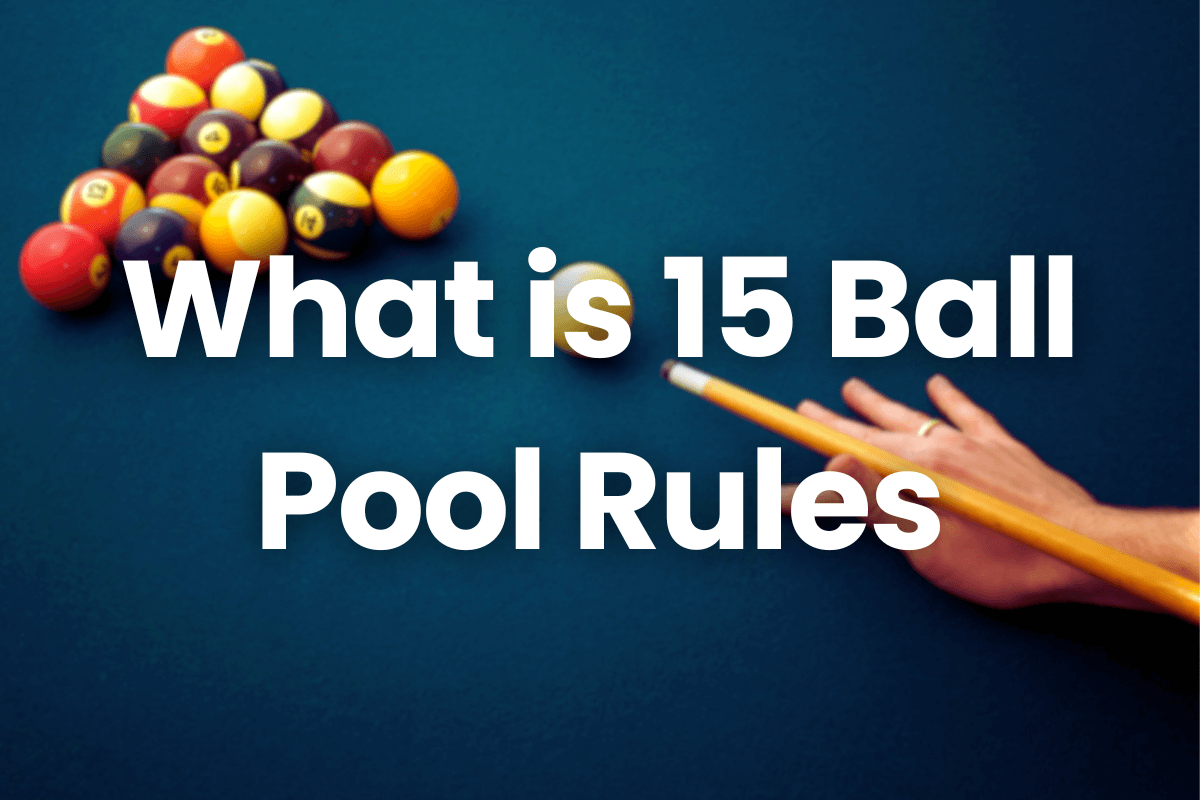Essential Guide to 15 Ball Pool Rules Explained (2024)
Welcome to the dynamic realm of “15 ball pool rules”, where each shot is a blend of strategy and precision. In this engaging cue sport, understanding the rules is essential for players of all levels. Beginners and seasoned players alike benefit from knowing the intricacies of the game. Grasping these rules is more than just learning how to play; it’s about honing your skills and strategy to excel. Let’s dive in and uncover the secrets of 15 ball pool, a game where knowledge is as important as skill.
15 Ball Pool: Overview and History
What is 15 Ball Pool?
15 ball pool, also known as straight pool or 14.1 continuous, is a popular cue sport. This game involves a standard set of 15 object balls and a cue ball. The objective is to score points by pocketing balls in a specific sequence. Each ball pocketed counts as a point, and the player who reaches a predetermined number of points first wins. Unlike other pool games, 15 ball pool requires players to call the ball and the pocket for each shot, making it a game of precision and strategy.
History and Evolution of 15 Ball Pool
Origins of the Game: The game of 15 ball pool has its roots in the early 20th century. It evolved from earlier pool games like continuous pool, where the objective was to score a continuous run of balls.
Popularity Boom: The game gained immense popularity in the United States in the 1920s and 1930s. It became a staple in pool tournaments and was considered the game of champions, testing the skills and strategies of players to the fullest.
Evolution of Rules: Over the years, the rules of 15 ball pool have seen several changes to enhance the game’s competitiveness and fairness. The introduction of the call shot rule, where players must specify the ball and pocket before each shot, was a significant change. This rule eliminated the luck element, making the game more skill-based.
Modern Era: Today, while games like eight-ball and nine-ball have surged in popularity, 15 ball pool remains a revered game among purists. It’s seen as a true test of a player’s skill, requiring not just technical prowess but also strategic planning and mental acuity.
Understanding the history and evolution of 15 ball pool gives players a deeper appreciation of the game.
Object of the Game: 15 Ball Pool
The Main Goal
In 15 ball pool, the ultimate aim is precision and strategy, not just pocketing balls. Each player strives to accumulate a set number of points before their opponent. These points are scored by pocketing balls, with each ball counting as one point.
How to Win
- Reaching the Point Target: The winner is the player who first reaches the predetermined point total, which is agreed upon before the game starts.
- Continuous Play: After all 15 balls are pocketed, they are re-racked, and the game continues until someone hits the point target.
- Strategic Play: Success in 15 ball pool isn’t just about shooting skills; it’s about planning your shots, playing defensively when needed, and always thinking a few moves ahead.
Equipment Used in 15 Ball Pool

The Pool Table
A standard 15 ball pool is played on a rectangular table, typically 9 feet long. The table has six pockets, one at each corner and two in the middle of the longer sides. The playing surface is covered with a smooth, finely woven cloth, often green, providing a consistent roll for the balls.
The Balls
There are 16 balls in total – 15 numbered object balls and 1 white cue ball. The object balls are numbered from 1 to 15, 1 through 7 are solid colors, 9 through 15 are stripes, and the 8 ball is solid black, creating a visual distinction for ease of play.
The Cue Stick
Cue sticks are typically made from wood or fiberglass, around 58 inches long, and designed for precision and control in shots.
Chalk: Used to increase friction between the cue tip and the cue ball, preventing miscues.
Rack: A triangle-shaped tool used to set up the balls at the game’s start.
How to properly rack the balls
Begin by placing the triangular rack at the foot of the table. The apex of the triangle points towards the opposite end of the table. Fill the rack with the 15 object balls without any specific order. Ensure they are tightly packed to prevent gaps, as this can affect the break’s effectiveness. Once all the balls are correctly positioned, carefully remove the rack without disturbing the formation.
Basic 15 Ball Pool Rules and Gameplay
Break Shot Rules and Fouling Penalties
Legal Break: A legal break requires the cue ball to hit the racked balls and at least four object balls must touch a cushion or a ball must be pocketed. Failing this, it’s a foul.
Penalty for Fouls: After a foul, the incoming player gets the cue ball in hand, meaning they can place it anywhere on the table for their shot.
Order of Play and “Call Shot” Rules
Taking Turns: Players take alternate turns. A player continues their turn as long as they legally pocket a called ball.
Call Shot Mechanism: Every shot must be a “call shot.” The player must specify the ball and the pocket. If they pocket a different ball or use a different pocket, it’s considered a foul.
Understanding Fouls and Their Consequences
Types of Fouls: Common fouls include failing to hit an object ball, pocketing the cue ball (scratch), and hitting the cue ball off the table.
Consequences: Fouls lead to loss of turn, with the opponent getting the cue ball in hand. Repeated fouls can lead to more severe penalties, like point deductions.
Scoring in 15 Ball Pool
Point System Explained
Points per Ball: In 15 ball pool, each object ball pocketed earns you one point.
Reaching the Target: The game is usually played to a predetermined number of points, often 100 or 150. The first player to reach this target wins.
Continuous Play: Once all 15 balls are pocketed, they’re re-racked, and play continues until someone hits the point target.
Strategies for Maximizing Points
Plan Your Shots: Aim to pocket balls in a way that sets up your next shot. Think a few moves ahead to maintain control of the table.
Control the Cue Ball: Skillful manipulation of the cue ball for position play is crucial. It allows for easier subsequent shots, increasing your chance to keep scoring.
Defensive Play: Sometimes, it’s strategic to play a defensive shot, ensuring your opponent doesn’t get an easy chance to score.
Ball Selection: Prioritize shots that are not only easy to pocket but also position the cue ball advantageously for the next shot.
Common Fouls and Penalties in 15 Ball Pool
List of Common Fouls
- Scratching: Pocketing the cue ball or knocking it off the table.
- Failing to Hit an Object Ball: Not making contact with any object ball with the cue ball.
- No Rail Contact: Failure of any ball to touch a rail post-contact when no ball is pocketed.
- Wrong Ball First: Hitting a ball other than the one called or in the wrong sequence.
- Potting the Wrong Ball: Accidentally pocketing a ball that wasn’t called.
Penalties for Each Foul
- Scratching: The incoming player gets the cue ball in hand, placing it anywhere on the table for their shot.
- Failing to Hit an Object Ball or No Rail Contact: Similar to scratching, this results in the incoming player having ball in hand.
- Wrong Ball First or Potting the Wrong Ball: These fouls also give the incoming player ball in hand, providing them a significant advantage to control the table.
Variations of 15 Ball Pool
Regional and Local Variations
- Straight Pool: Also known as 14.1 continuous, where players must reach a certain number of points, typically 100 or 150, to win.
- Rotation Pool: Each ball has a point value corresponding to its number, and players must hit the lowest-numbered ball on the table first.
- One Pocket: A variation where each player is assigned one of the corner pockets and must pocket all of their balls into that pocket.
Impact on Basic Rules
- Straight Pool: The basic rules remain similar, but the strategy changes as players continuously aim to reach the set point target.
- Rotation Pool: This variation changes the order in which balls must be hit, adding an extra layer of strategy and skill.
- One Pocket: Here, the focus shifts from scoring points to pocketing balls in a specific pocket, altering the game’s tactical approach.
Conclusion
Mastering the rules of 15 ball pool is pivotal to excelling in this strategic and skillful game. From the precise setup and break shot to understanding fouls and their penalties, each rule forms the foundation of play. The scoring system and the art of calling shots demand not just skill but also tactical thinking. Variations like Straight Pool, Rotation, and One Pocket introduce diverse challenges, enriching your pool experience. Remember, continuous practice and a willingness to learn are key to mastering this game. Embrace these rules, refine your techniques, and you’ll not only enjoy the game more but also see your skills soar to new heights.
FAQs
Can you explain the ‘call shot’ rule in 15 ball pool?
In 15 ball pool, players must call their shots, specifying the ball and the pocket for each shot. If a player pockets a different ball or uses a different pocket than called, it’s considered a foul. This rule adds a strategic layer to the game, emphasizing precision and planning.
What are the key strategies for maximizing points in 15 ball pool?
Key strategies include planning shots to set up for subsequent ones, controlling the cue ball for better positioning, choosing shots that not only pocket balls but also favor future plays, and sometimes opting for defensive shots to limit the opponent’s scoring opportunities.
How important is understanding the rules and variations of 15 ball pool?
Understanding the rules is fundamental to playing effectively and competitively. Knowing variations like Straight Pool or One Pocket can enhance your adaptability and enjoyment of the game. These variations require different strategies and skills, adding depth to your overall understanding of pool.
What is the significance of the break shot in 15 ball pool?
The break shot is crucial in 15 ball pool. A legal break requires hitting the racked balls so that at least four balls touch a cushion or a ball is pocketed. A successful break can strategically scatter the balls and potentially pocket some, offering a significant advantage in the game.







